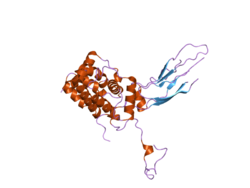- OCRL
-
Inositol polyphosphate 5-phosphatase OCRL-1 (INPP5F) also known as Lowe oculocerebrorenal syndrome protein is an enzyme that in humans is encoded by the OCRL gene located on the X chromosome.[1]
This gene encodes a phosphatase enzyme that is involved in actin polymerization and is found in the trans-Golgi network.[1]
Contents
Clinical significance
Mutation in this gene are associated with oculocerebrorenal syndrome[2] and also with Dent's disease.[3][4]
References
- ^ a b "Entrez Gene: oculocerebrorenal syndrome of Lowe". http://www.ncbi.nlm.nih.gov/sites/entrez?Db=gene&Cmd=ShowDetailView&TermToSearch=4952.
- ^ Kawano T, Indo Y, Nakazato H, Shimadzu M, Matsuda I (June 1998). "Oculocerebrorenal syndrome of Lowe: three mutations in the OCRL1 gene derived from three patients with different phenotypes". Am. J. Med. Genet. 77 (5): 348–55. doi:10.1002/(SICI)1096-8628(19980605)77:5<348::AID-AJMG2>3.0.CO;2-J. PMID 9632163.
- ^ Online 'Mendelian Inheritance in Man' (OMIM) 300555
- ^ Hoopes RR, Shrimpton AE, Knohl SJ, et al. (February 2005). "Dent Disease with mutations in OCRL1". Am. J. Hum. Genet. 76 (2): 260–7. doi:10.1086/427887. PMC 1196371. PMID 15627218. http://linkinghub.elsevier.com/retrieve/pii/S0002-9297(07)62577-4.
Further reading
- Ross MT, Grafham DV, Coffey AJ, et al. (2005). "The DNA sequence of the human X chromosome.". Nature 434 (7031): 325–37. doi:10.1038/nature03440. PMC 2665286. PMID 15772651. http://www.pubmedcentral.nih.gov/articlerender.fcgi?tool=pmcentrez&artid=2665286.
- Erdmann KS, Mao Y, McCrea HJ, et al. (2007). "A role of the Lowe syndrome protein OCRL in early steps of the endocytic pathway.". Dev. Cell 13 (3): 377–90. doi:10.1016/j.devcel.2007.08.004. PMID 17765681.
- Hyvola N, Diao A, McKenzie E, et al. (2006). "Membrane targeting and activation of the Lowe syndrome protein OCRL1 by rab GTPases.". EMBO J. 25 (16): 3750–61. doi:10.1038/sj.emboj.7601274. PMID 16902405.
- Mao Y, Balkin DM, Zoncu R, et al. (2009). "A PH domain within OCRL bridges clathrin-mediated membrane trafficking to phosphoinositide metabolism.". EMBO J. 28 (13): 1831–42. doi:10.1038/emboj.2009.155. PMID 19536138.
- Suchy SF, Cronin JC, Nussbaum RL (2009). "Abnormal bradykinin signalling in fibroblasts deficient in the PIP(2) 5-phosphatase, ocrl1.". J. Inherit. Metab. Dis. 32 (2): 280–8. doi:10.1007/s10545-009-1058-3. PMID 19172411.
- Wu F, Reed AA, Williams SE, et al. (2009). "Mutational analysis of CLC-5, cofilin and CLC-4 in patients with Dent's disease.". Nephron Physiol 112 (4): p53-62. doi:10.1159/000225944. PMID 19546591.
- Coon BG, Mukherjee D, Hanna CB, et al. (2009). "Lowe syndrome patient fibroblasts display Ocrl1-specific cell migration defects that cannot be rescued by the homologous Inpp5b phosphatase.". Hum. Mol. Genet. 18 (23): 4478–91. doi:10.1093/hmg/ddp407. PMID 19700499.
- Tosetto E, Addis M, Caridi G, et al. (2009). "Locus heterogeneity of Dent's disease: OCRL1 and TMEM27 genes in patients with no CLCN5 mutations.". Pediatr. Nephrol. 24 (10): 1967–73. doi:10.1007/s00467-009-1228-4. PMID 19582483.
- Faucherre A, Desbois P, Nagano F, et al. (2005). "Lowe syndrome protein Ocrl1 is translocated to membrane ruffles upon Rac GTPase activation: a new perspective on Lowe syndrome pathophysiology.". Hum. Mol. Genet. 14 (11): 1441–8. doi:10.1093/hmg/ddi153. PMID 15829501.
- Shrimpton AE, Hoopes RR, Knohl SJ, et al. (2009). "OCRL1 mutations in Dent 2 patients suggest a mechanism for phenotypic variability.". Nephron Physiol 112 (2): p27-36. doi:10.1159/000213506. PMID 19390221.
- Sekine T, Nozu K, Iyengar R, et al. (2007). "OCRL1 mutations in patients with Dent disease phenotype in Japan.". Pediatr. Nephrol. 22 (7): 975–80. doi:10.1007/s00467-007-0454-x. PMID 17384968.
- Chabaâ L, Monnier N, Dahri S, et al.. "[Oculo-cerebro-renal Lowe syndrome: clinical, biochemical and molecular studies in a Moroccan patient]". Ann. Biol. Clin. (Paris) 64 (1): 53–9. PMID 16420990.
- Choudhury R, Diao A, Zhang F, et al. (2005). "Lowe syndrome protein OCRL1 interacts with clathrin and regulates protein trafficking between endosomes and the trans-Golgi network.". Mol. Biol. Cell 16 (8): 3467–79. doi:10.1091/mbc.E05-02-0120. PMID 15917292.
- Sethi SK, Bagga A, Gulati A, et al. (2008). "Mutations in OCRL1 gene in Indian children with Lowe syndrome.". Clin. Exp. Nephrol. 12 (5): 358–62. doi:10.1007/s10157-008-0059-0. PMID 18500547.
- Cui S, Guerriero CJ, Szalinski CM, et al. (2010). "OCRL1 function in renal epithelial membrane traffic.". Am. J. Physiol. Renal Physiol. 298 (2): F335-45. doi:10.1152/ajprenal.00453.2009. PMID 19940034.
- McCrea HJ, Paradise S, Tomasini L, et al. (2008). "All known patient mutations in the ASH-RhoGAP domains of OCRL affect targeting and APPL1 binding.". Biochem. Biophys. Res. Commun. 369 (2): 493–9. doi:10.1016/j.bbrc.2008.02.067. PMID 18307981.
- Hoopes RR, Shrimpton AE, Knohl SJ, et al. (2005). "Dent Disease with mutations in OCRL1.". Am. J. Hum. Genet. 76 (2): 260–7. doi:10.1086/427887. PMC 1196371. PMID 15627218. http://www.pubmedcentral.nih.gov/articlerender.fcgi?tool=pmcentrez&artid=1196371.
- Levtchenko EN, Monnens LA, Bökenkamp A, Knoers NV (2007). "[From gene to disease; Dent's disease caused by abnormalities in the CLCN5 and OCRL1 genes]". Ned Tijdschr Geneeskd 151 (43): 2377–80. PMID 18019214.
- Choudhury R, Noakes CJ, McKenzie E, et al. (2009). "Differential clathrin binding and subcellular localization of OCRL1 splice isoforms.". J. Biol. Chem. 284 (15): 9965–73. doi:10.1074/jbc.M807442200. PMID 19211563.
- Swan LE, Tomasini L, Pirruccello M, et al. (2010). "Two closely related endocytic proteins that share a common OCRL-binding motif with APPL1.". Proc. Natl. Acad. Sci. U.S.A. 107 (8): 3511–6. doi:10.1073/pnas.0914658107. PMID 20133602.
External links
Hydrolase: esterases (EC 3.1) 3.1.1: Carboxylic ester hydrolases Cholinesterase (Acetylcholinesterase, Butyrylcholinesterase) · Pectinesterase · 6-phosphogluconolactonase · PAF acetylhydrolase
Lipase (Bile salt-dependent, Gastric/Lingual, Pancreatic, Lysosomal, Hormone-sensitive, Endothelial, Hepatic, Lipoprotein, Monoacylglycerol, Diacylglycerol)
Phospholipase (A1, A2, B)3.1.2: Thioesterase 3.1.3: Phosphatase Alkaline phosphatase (ALPI, ALPL, ALPP) · Acid phosphatase (Prostatic)/Tartrate-resistant acid phosphatase/Purple acid phosphatases · Nucleotidase · Glucose 6-phosphatase · Fructose 1,6-bisphosphatase · Calcineurin · Phosphoprotein phosphatase (PP2A) · OCRL · Pyruvate dehydrogenase phosphatase · Fructose 6-P,2-kinase:fructose 2,6-bisphosphatase · PTEN · Phytase · Inositol-phosphate phosphatase (IMPA1)
Phosphoprotein phosphatase: Protein tyrosine phosphatase · Protein serine/threonine phosphatase · Dual-specificity phosphatase3.1.4: Phosphodiesterase Autotaxin · Phospholipase (C, D) · Sphingomyelin phosphodiesterase (1) · PDE1 · PDE2 · PDE3 · PDE4A/PDE4B · PDE5 · Lecithinase (Clostridium perfringens alpha toxin) · Cyclic nucleotide phosphodiesterase3.1.6: Sulfatase Nuclease (includes
deoxyribonuclease and
ribonuclease)either deoxy- or ribo-B enzm: 1.1/2/3/4/5/6/7/8/10/11/13/14/15-18, 2.1/2/3/4/5/6/7/8, 2.7.10, 2.7.11-12, 3.1/2/3/4/5/6/7, 3.1.3.48, 3.4.21/22/23/24, 4.1/2/3/4/5/6, 5.1/2/3/4/99, 6.1-3/4/5-6 Categories:- Human proteins
- Biochemistry stubs
Wikimedia Foundation. 2010.

